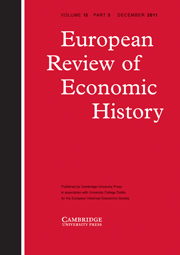Article contents
The logic of compromise: Monetary bargaining in Austria-Hungary, 1867–1913
Published online by Cambridge University Press: 20 April 2006
Abstract
This article examines the historical record of the Austro-Hungarian monetary union, focusing on its bargaining dimension. As a result of the 1867 Compromise, Austria and Hungary shared a common currency, although they were fiscally sovereign and independent entities. By using repeated threats to quit, Hungary succeeded in obtaining more than proportional control and forcing the common central bank into a policy that was very favourable to it. Using insights from public economics, this article explains the reasons for this outcome. Because Hungary would have been able to secure quite good conditions for itself had it broken apart, Austria had to provide its counterpart with incentives to stay on board. I conclude that the eventual split of Hungary after World War I was therefore not ‘written on the wall’ in 1914, since the Austro-Hungarian monetary union was quite profitable to Hungarians.
- Type
- Research Article
- Information
- Copyright
- Cambridge University Press 2006
- 13
- Cited by


